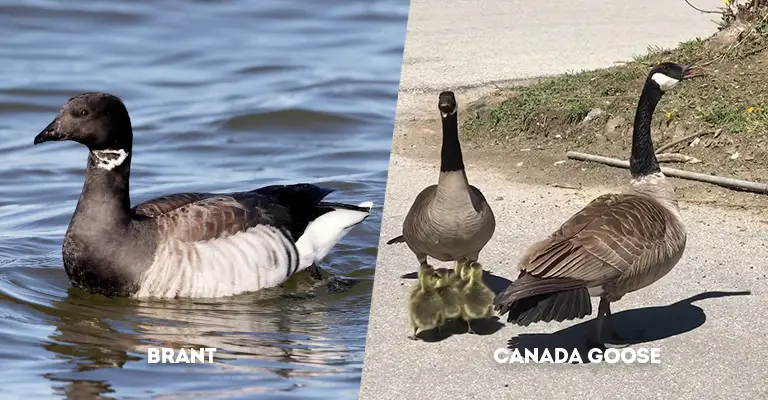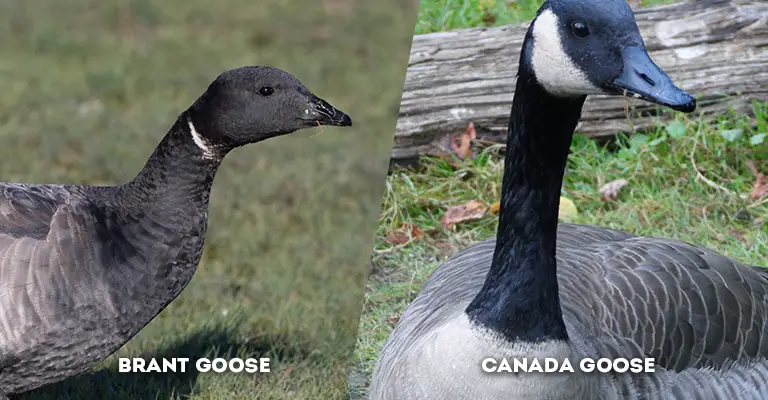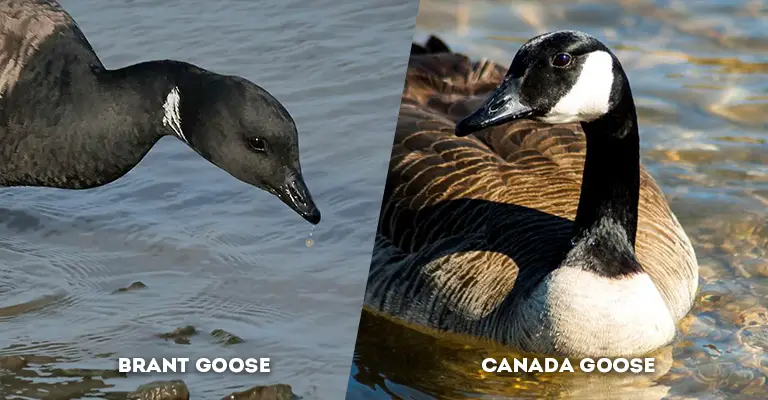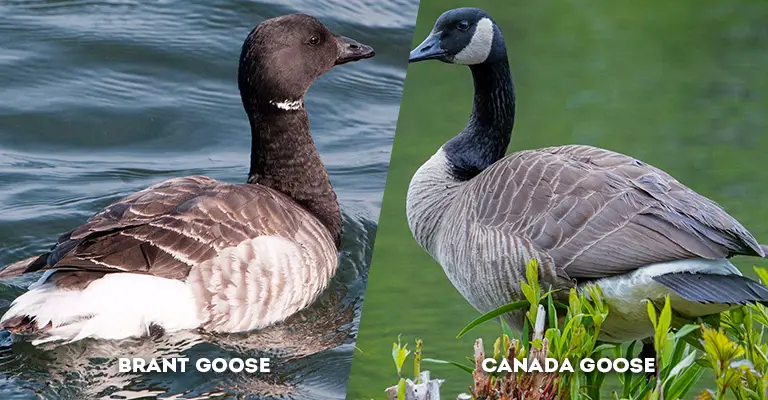Waterfowl species, such as the brant goose and the Canada goose, captivate observers with their diverse behaviors, unique adaptations, and ecological significance.
These avian inhabitants of various habitats across North America and beyond demonstrate remarkable differences in terms of migration patterns, physical characteristics, nesting habits, behavior, and foraging strategies.
From the elegant coastlines where brant geese thrive to the adaptable urban landscapes favored by Canadian geese, the intricacies of their interactions with the environment underscore the intricate interplay between form, function, and survival.
This exploration delves into the distinctive attributes that shape their roles within ecosystems and their captivating journeys through diverse habitats.

Key Differences Between Brant and Canada Goose
Brant and Canada Goose are both waterfowl species that belong to the family Anatidae, but they have distinct differences in terms of appearance, behavior, habitat, and range.
Here are some key differences between the two:
Size
- Brant Goose: The brant goose is notably smaller in size, with a streamlined physique. Its compact build contributes to its efficient navigation in coastal environments.
This species exhibits a shorter neck, which adds to its distinct appearance. These physical traits are adaptations to its preferred marine habitats and feeding habits. - Canada Goose: In contrast, the Canada goose is larger in size, and characterized by a robust body. Its long neck and imposing presence set it apart. The elongated neck facilitates reaching submerged vegetation in freshwater habitats.
This species’ size and structure enable it to thrive in a range of environments, from urban parks to rural fields.
Neck Length

- Brant Goose: The brant goose is recognized for its shorter neck, which is one of its defining attributes. This adaptation is well-suited for its preferred coastal habitat.
With a shorter neck, the brant goose can efficiently navigate and forage in intertidal zones, where it primarily feeds on seagrasses, aquatic vegetation, and algae.
The compact neck aids in its streamlined movement and enhances its ability to exploit marine food sources. - Canada Goose: Conversely, the Canada goose boasts a longer neck, a feature that contributes to its versatile foraging behavior. The elongated neck allows this species to reach submerged aquatic vegetation in lakes, rivers, and ponds.
It’s an adaptation that suits their wide-ranging habitat preferences and dietary habits. Whether grazing in fields or swimming in freshwater habitats, the Canada goose’s neck is an essential tool for accessing a variety of food sources.
Head Color

- Brant Goose: The head of the brant goose is predominantly black, providing a stark contrast to its body. This dark coloration serves as a camouflage mechanism, especially in its preferred coastal environments.
The dark head helps the brant goose blend in with the rocks and seaweed along shorelines, offering protection against potential predators and contributing to its survival in these habitats. - Canada Goose: In contrast, the Canada goose also has a black head, but it’s marked by a prominent white “chinstrap.” This white marking extends from one side of the head to the other, highlighting the throat and lower part of the face.
This distinctive feature aids in species identification and can be particularly striking against the bird’s brownish-gray body. The contrast between the dark head and the white chinstrap is a characteristic feature of the Canada goose.
Cheeks
- Brant Goose: Unlike the Canada goose, the brant goose lacks prominent white cheeks. Instead, it has a more uniform dark coloration on its head.
This absence of white cheek patches is compensated by its “bibbed” appearance a narrow white neck ring that encircles the lower part of its neck.
The bibbed appearance adds a unique touch to its overall look and helps distinguish it from other goose species. - Canada Goose: The Canada goose is characterized by its white cheeks, contrasting with the black head. These white cheek patches are a key identifying feature and contribute to the Canada goose’s distinct appearance.
The combination of the white cheeks and the black head with the white chinstrap creates a striking and recognizable facial pattern.
Body Color

- Brant Goose: The body of the brant goose is notably dark, complementing its habitat and foraging behavior. The dark coloration blends well with the rocky and seaweed-covered coastal areas it frequents.
This adaptation provides camouflage and protection against potential predators, allowing the brant goose to navigate its environment with a measure of safety. - Canada Goose: The Canada goose exhibits a brownish-gray body color with a white chest and a black rear end. This coloration is versatile and provides a degree of camouflage in various habitats.
The lighter chest color may help the Canada goose blend in with grassy landscapes, while the darker rear end can offer protection while swimming in water bodies.
Habitat
- Brant Goose: The brant goose is closely associated with coastal habitats, particularly marine environments. These geese are often found along shorelines, rocky coasts, and intertidal zones.
Their preference for coastal habitats aligns with their feeding habits, as they primarily consume seagrasses, aquatic vegetation, and algae. - Canada Goose: Conversely, the Canada goose displays remarkable adaptability and can thrive in a wide range of habitats. They are often found in freshwater environments such as lakes, rivers, and ponds.
However, they are also known to inhabit urban areas like parks, golf courses, and agricultural fields. This adaptability is partly due to their versatile diet, which includes grasses, crops, and aquatic plants.
Distribution
- Brant Goose: The brant goose has a circumpolar distribution, breeding in the Arctic regions of North America, Europe, and Asia.
During the breeding season, they inhabit tundra areas near the coast. As winter approaches, they migrate to coastal regions, particularly along the Atlantic and Pacific coasts of North America, as well as in Europe and Asia. - Canada Goose: The Canada goose is native to North America and boasts a widespread distribution throughout the continent.
They can be found in various regions, from northern Canada to the southern United States. Some populations of Canada geese are migratory, traveling across different regions based on seasonal changes.
Wintering Areas
- Brant Goose: Brant geese migrate to coastal areas for winter, where they continue to utilize marine habitats for food. These coastal areas provide a consistent supply of seagrasses and algae, which constitute a significant portion of their diet.
Their wintering grounds are often shared with other waterfowl species, as they take advantage of the rich resources offered by these coastal ecosystems. - Canada Goose: Depending on the population, Canada geese exhibit various wintering patterns. Some populations are migratory and may travel south to warmer regions for the winter, including parts of the United States and Mexico.
However, many Canadian geese are also known to stay in their breeding regions throughout the year if food resources and habitat conditions remain favorable.
Feeding Habits
- Brant Goose: The brant goose’s feeding habits are closely tied to its coastal habitat preference. Its diet primarily consists of seagrasses, algae, and aquatic vegetation.
Their shorter necks and streamlined bodies allow them to dive and forage efficiently in shallow waters along coastlines. Their consumption of marine plants contributes to nutrient cycling in coastal ecosystems. - Canada Goose: Canada geese are known for their versatile feeding habits. They graze on grasses, agricultural crops, and aquatic plants.
Their long necks enable them to reach submerged vegetation in water bodies, making them well-suited for feeding in various environments. This adaptability to different food sources has contributed to their successful colonization of diverse habitats.
Vocalizations
- Brant Goose: Brant geese are recognized for their soft and musical calls, which stand in contrast to the louder honks of some other waterfowl species.
Their calls often consist of melodic, flute-like notes that can be heard as they communicate with other members of their flock or alert each other to potential threats. - Canada Goose: The vocalizations of Canada geese are iconic and distinct. They are known for their loud, resonant honks that can carry over long distances.
These honks serve various purposes, including communication within the flock during migration, establishing territory, and warning of perceived dangers. Their honking calls are a hallmark of their presence in both urban and natural habitats.
Migration Patterns
- Brant Goose: Brant geese engage in notable migrations as they move between their breeding and wintering grounds. These migrations often span thousands of kilometers.
During the breeding season, brant geese inhabit Arctic tundra regions, where they nest and raise their young.
As winter approaches, they embark on long-distance migrations to coastal areas, where they take advantage of marine food sources. - Canada Goose: The migration patterns of Canadian geese can be quite diverse, influenced by the geographic location and environmental conditions of their breeding grounds.
Some populations of Canada geese are migratory and undertake seasonal journeys between their breeding and wintering areas.
Others, however, have become more sedentary, particularly in areas where food resources remain available year-round.
Neck Appearance
- Brant Goose: The brant goose is characterized by a shorter neck, which contributes to its streamlined appearance.
This adaptation suits its preferred coastal habitat, allowing it to efficiently navigate rocky shorelines and shallow waters while foraging on seagrasses and aquatic vegetation.
Additionally, the brant goose’s neck often showcases a distinctive narrow white neck ring, creating a “bibbed” effect that sets it apart. - Canada Goose: The Canada goose stands out with its long neck, an adaptation that suits its diverse feeding habits.
The extended neck enables the bird to reach submerged vegetation in water bodies, including lakes, rivers, and ponds. This versatile neck structure has contributed to the Canada goose’s ability to thrive in various environments and adapt to different food sources.
Bill Color
- Brant Goose: The brant goose typically features a dark-colored bill that complements its overall darker plumage. This bill coloration aligns with its marine habitat and diet of seagrasses and algae.
The dark bill blends in with the coastal rocks and seaweed, providing camouflage and protection in its environment. - Canada Goose: The Canada goose exhibits variable bill coloration, with differences between subspecies and individual birds.
While many have black bills, some individuals can have paler bills with pink or orange tones. This variation may be related to factors such as diet and genetics.
Body Shape
- Brant Goose: The brant goose’s body shape is streamlined and compact, a design that enhances its ability to navigate coastal environments.
This form helps it efficiently fly long distances during migration and move adeptly through rocky intertidal zones as it forages for food. - Canada Goose: The Canada goose possesses a stockier and more robust body shape compared to the brant goose. This physique provides insulation and energy storage, aiding the bird during migrations and in colder climates.
Preferred Environment
- Brant Goose: The brant goose thrives in coastal environments, particularly areas with rocky shorelines and intertidal zones. These habitats offer access to its preferred marine food sources and align with its streamlined body and foraging behavior.
- Canada Goose: Canada geese exhibit adaptability to a wide range of environments. They can be found in freshwater habitats such as lakes, rivers, and ponds, as well as in urban areas like parks and golf courses.
Their versatile feeding habits and ability to exploit various food sources contribute to their success in diverse landscapes.
Range
- Brant Goose: The range of the brant goose encompasses circumpolar regions, spanning Arctic breeding grounds in North America, Europe, and Asia.
As winter approaches, they migrate to coastal areas in North America, Europe, and Asia, seeking suitable marine feeding habitats. This extensive range showcases their adaptability to varied climates and ecosystems. - Canada Goose: The Canada goose has a wide distribution throughout North America, from northern Canada to parts of the United States.
Some populations are also found in Europe and other regions where they have been introduced. Their presence in both urban and natural landscapes highlights their adaptability to diverse environments.
Reproductive Behavior
- Brant Goose: Brant geese engage in monogamous pair bonding, often forming lifelong partnerships. They typically nest on the ground in Arctic tundra regions.
Their reproductive success hinges on the timing of their migrations to and from breeding grounds, ensuring the availability of suitable nesting sites and ample food resources for their young. - Canada Goose: Canada geese also exhibit monogamous pair bonding, forming strong bonds that often persist beyond the breeding season.
They build nests in a variety of locations, including on the ground, in nests made of vegetation, and even on structures like buildings and platforms. Their adaptability in selecting nesting sites contributes to their reproductive success.
Nesting Sites
- Brant Goose: Brant geese typically nest on the ground in the Arctic tundra. These nests are often situated in areas with good visibility, allowing adults to keep watch for predators while tending to their eggs and young. The choice of nesting sites is influenced by the availability of suitable vegetation and protection from predators.
- Canada Goose: Canada geese exhibit a wide range of nesting site preferences. They build nests in various locations, including near water bodies, on islands, and even in urban environments. Their adaptability to nesting on different surfaces and structures contributes to their success in colonizing a variety of habitats.
Behavior
- Brant Goose: Brant geese exhibit a relatively calm and less aggressive behavior compared to some other goose species. They are often seen foraging in flocks along coastal areas.
Their musical calls contribute to a harmonious soundscape, and their interactions with each other are characterized by social cohesiveness. - Canada Goose: Canada geese are known for their honking calls and more assertive behavior, particularly during the breeding season.
They can be territorial and defend their nesting sites vigorously. Their presence in urban areas sometimes leads to interactions with humans, both positive and negative.
Foraging Behavior
- Brant Goose: The foraging behavior of brant geese centers on marine habitats, where they feed on seagrasses, algae, and aquatic vegetation.
They often dive underwater to access their food sources, using their streamlined bodies and shorter necks to navigate the shallows and efficiently obtain sustenance. - Canada Goose: Canada geese are versatile foragers, consuming a wide range of food sources. They graze on grasses, aquatic plants, and crops, both on land and in water.
Their long necks allow them to reach submerged vegetation, and their adaptable diet contributes to their ability to thrive in diverse habitats.
Brant Vs Canada Goose: Comparison Table
| Aspect | Brant Goose | Canada Goose |
|---|---|---|
| Size | Smaller size | Larger size |
| Neck | Short neck with white neck ring | Long black neck with white chinstrap |
| Head Color | Black-headed | Black-headed |
| Cheeks | Lack white cheeks | White cheeks |
| Body Color | Dark coloration | Brownish-gray body with white chest |
| Habitat | Coastal areas, marine environments | Versatile, found in various habitats |
| Distribution | Circumpolar, breeding in Arctic regions | Native to North America, widespread |
| Wintering Areas | Coastal areas | Various habitats, including urban areas |
| Feeding Habits | Feeds on seagrasses, aquatic vegetation | Grazes on grasses, agricultural areas |
| Vocalizations | Soft musical calls | Loud honking calls |
| Migration Patterns | Migrates to coastal regions | Migrates across continents, various routes |
| Neck Appearance | White neck ring, “bibbed” appearance | White chinstrap on black neck |
| Bill Color | Dark bill | Variable bill color |
| Body Shape | Streamlined | Stockier and robust |
| Preferred Environment | Coastal shorelines | Lakes, rivers, ponds, urban areas |
| Range | Breeds in Arctic regions, circumpolar | Widespread in North America |
| Reproductive Behavior | Breeds in Arctic tundra areas | Nests in a variety of habitats |
| Nesting Sites | Ground nesting | Often nests in elevated areas |
| Behavior | More associated with marine environments | Adaptable, found in diverse settings |
| Foraging Behavior | Feeds on seagrasses and algae | Grazes on grasses, crops, and vegetation |
Frequently Asked Questions
Brant geese undertake long-distance migrations between their Arctic breeding grounds and coastal wintering areas in North America, Europe, and Asia.
Canada geese exhibit diverse migration patterns, with some populations being migratory, traveling south for the winter, while others remain sedentary in their breeding regions if food resources are available.
Canada geese are adaptable in their choice of nesting sites. They build nests near water bodies, on islands, and even in urban environments. Their nesting sites can vary widely, from natural landscapes to artificial structures like buildings and platforms.
Brant geese generally exhibit calmer behavior during the breeding season, focusing on tending to their nests and young.
In contrast, Canadian geese can be more assertive and territorial, defending their nesting sites vigorously and interacting with other geese and humans in a more noticeable manner.
Vocalizations serve different functions for brant geese and Canadian geese. Brant geese are known for their soft and musical calls that aid in communication within their flocks.
Canada geese use their resonant honking calls for various purposes, including communication during migration, establishing territory, and alerting others to potential threats.
The streamlined body shape of brant geese suits their coastal habitat and foraging behavior. This shape enables them to navigate rocky shorelines and shallow waters efficiently.
Canada geese have a stockier and more robust body shape, which provides insulation and energy storage, aiding them during migration and in colder climates.
To Recap
In the vibrant tapestry of avian diversity, the brant goose and the Canada goose stand as emblematic representatives, each with their own chapter in the avian story.
From the majestic flight formations of their migrations to the careful selection of nesting sites, these geese illuminate the profound connections between their behaviors and the environments they inhabit.
Through their diverse adaptations, behaviors, and ecological roles, the brant and Canada geese remind us of the intricate balance that exists in nature, where every quirk of form and every nuance of behavior contribute to the intricate symphony of life that unfolds across the landscapes they call home.